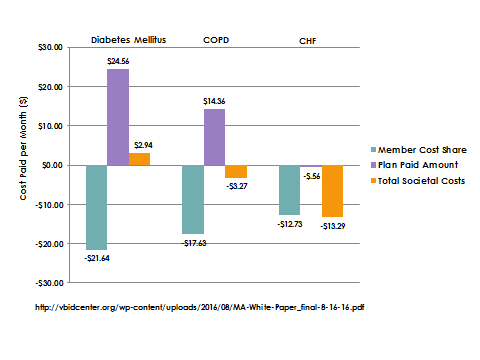Article
Implementing VBID in Medicare and Medicare Advantage
Author(s):
In current Medicare benefit designs, out-of-pocket costs do not reflect the expected clinical benefit or value of care. Research indicates that increasing patient cost sharing not only reduces the use of non-essential care, but also reduces the utilization of essential care.
This article was collaboratively written by A. Mark Fendrick, MD, director of the V-BID Center, and several V-BID Center staff.
To contain Medicare spending increases without compromising quality of care, policy makers are exploring consumer-facing strategies that compliment provider-facing payment reforms. As healthcare expenditures have risen, payers have tried to alleviate the pressure on premiums by increasing patients’ cost-sharing at the point of ser­vice. In current Medicare benefit designs, out-of-pocket costs do not reflect the expected clinical benefit or value of care. Research indicates that increasing patient cost sharing not only reduces the use of non-essential care, but also reduces the utilization of essential care. Thus, more sophis­ticated benefit designs that can replace the traditional blunt cost-sharing structures are warranted.
Value-based insurance design (VBID) focuses on en­couraging efficient use of services by aligning patients’ out-of-pocket costs, such as copayments and deductibles, with the value of services. Essential to VBID are the tenants of "clinical nuance," which acknowledge that medical services differ in the amount of health produced, and the clinical benefit derived from a specific service depends on the consumer using it, as well as when and where the service is provided. Implementation of clinically nuanced cost sharing has been driven by private payers and was included in Section 2713 of the Patient Protection and Affordable Care Act (ACA), which eliminates patient cost-sharing for primary preventive services (for specified popula­tions) as selected by the US Preventive Services Task Force, the CDC, and other agencies.
Incorporation of VBID principles into Medicare and Medicare Advantage (MA) plans has garnered broad multi-stakeholder and bipartisan political support. The “Seniors’ Medication Copayment Reduction Act” (2009 S. 1040) sought to remove consumer cost barriers associated with high-value medications for conditions such as diabetes, asthma, and depression. VBID was highlighted in the 2010-2012 Medicare Payment Advisory Commission Reports to Congress. Subsequently, the bipartisan, bicameral, “Better Care, Lower Cost Act of 2014” (S.1932), called for an elective program that reduced cost sharing for high-value services for Medicare beneficiaries with chronic conditions.
Figure 1. MA VBID Model Test
Most notably, in 2015, “The Strengthening Medicare Advantage through Innovation and Transparency for Seniors Act of 2015” (HR 2750) was passed with strong bipartisan support in the House of Representatives, directing the secretary of HHS to establish a demonstration program allowing MA plans to test VBID principles. Shortly thereafter, CMS announced an MA VBID model test to assess the utility of structuring consumer cost sharing and health plan elements to encourage the use of high-value clinical services and providers. This demonstration was later expanded in 2016 to include 3 new states and 2 new chronic conditions.

An actuarial analysis of the fiscal implications of condition-specific MA VBID programs from the patient, plan, and societal perspectives was undertaken for diabetes, chronic obstructive pulmonary disease (COPD), and congestive heart failure (CHF) (Figure 2). The VBID programs reduced consumer out-of-pocket costs in all 3 conditions. Plan costs increased slightly for diabetes and COPD; there were savings in the plan for CHF. From the societal perspective, the diabetes program was close to cost neutral; there were net societal savings in the COPD and CHF programs.

VBID principles can be used to create MA plan designs that are better aligned with value. Encouraging the use of high-value services and providers, and discouraging those with low value, will decrease cost-related nonadherence, reduce healthcare disparities, and improve the efficiency of healthcare spending without compromising quality. The use of clinical nuance to set out-of-pocket costs for Medicare beneficiaries would have significant positive impacts, providing consumers with better access to quality services and resulting in a healthier population.





